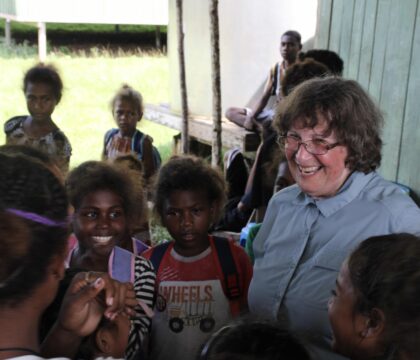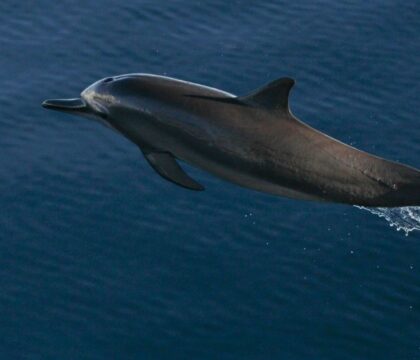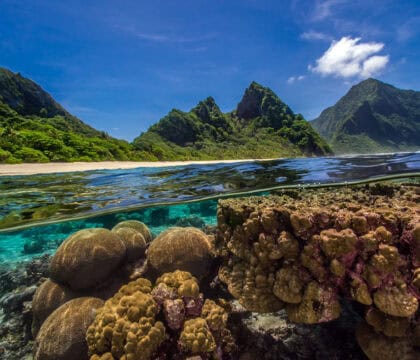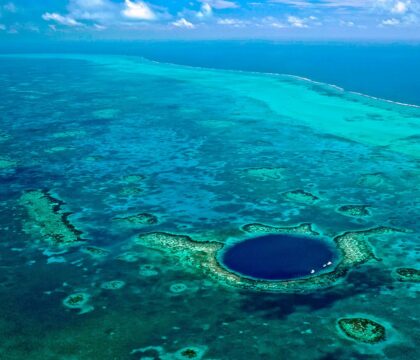July 9, 2020 • Field Notes, Ocean Facts, Travel Ideas
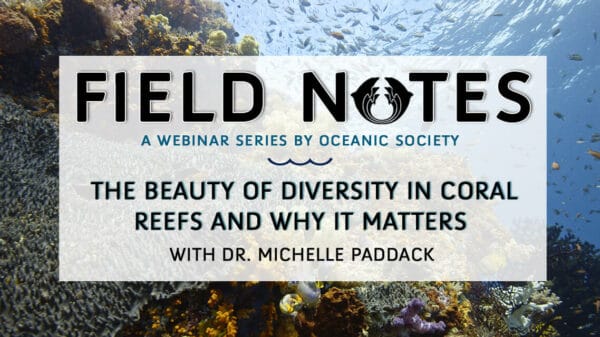
We are pleased to share with you a recording of our inaugural Field Notes webinar, ‘The Beauty of Diversity in Coral Reefs and Why it Matters’ with Dr. Michelle Paddack, hosted by Wayne Sentman, Oceanic Society’s Director of Conservation Travel Programs. Below you can also find a written version of the excellent Q&A that followed Michelle’s presentation, as well as travel opportunities, and ways to stay engaged with ocean conservation during this time.
If you are not already on our mailing list, please be sure to sign up here, and/or follow us on Facebook, Instagram, and Twitter to make sure you receive the announcements for future Field Notes.
Questions & Answers
Questions have been organized beneath subheadings for convenience. Written responses are included below. For questions that were answered live, we have provided the timecode to watch the answer in the webinar recording.
Travel & Tourism Related
Q1: Is the November Palau trip available for volunteers?
A: No, Oceanic Society’s November Palau expedition is a snorkeling program and does not include research. Dates and more information about our next coral reef volunteer program can be found here: Palau: Shark and Coral Reef Monitoring
Q2: Would like to know where would be good locations to snorkel and see different species of turtles. Either now or as a potential future topic. Thank you for this opportunity
A: It is possible to see sea turtles while snorkeling in many locations worldwide. Of the locations that Oceanic Society visits, the following offer the highest possibility to see turtles while snorkeling: Palau (hawksbill and green turtles); Raja Ampat, Indonesia and other parts of the Coral Triangle (hawksbill and green turtles); Borneo (green turtles, on our Sipadan extension specifically); Galapagos Islands (green turtles): and Belize (loggerhead turtles). We also offer expeditions that include the chance to see nesting sea turtles, in Costa Rica (olive ridley turtles) and Trinidad (leatherback turtles). Beyond Oceanic Society’s destinations, Hawaii is always a sure bet!
Q3: What opportunities are available for GIS professionals – research divers with Oceanic?
A: The program that would likely be the most suited to you would be the volunteer expedition that Michelle leads in Palau looking at shark numbers and coral reef health. Go here for more information.
Q4: Michelle, any plans for a Fiji volunteer scuba trip?
A: Answered live, see 47:06.
Q5: Does Oceanic Society do snorkel trips in the Philippines?
A: Not at the moment, but we probably will in 2022. Please be sure to subscribe to our catalog mailing list to stay in touch.
Q6: How does ecotourism protect the coral reefs?
A: Answered live, see 55:23.
Q7: How much does non-harvesting recreational use of nearshore water disturb the fish populations?
A: Answered live, see 55:23.
Conservation Issues – Fisheries
Q: If overfishing the oceans is the biggest problem we are facing in the oceans, how does coral health affect this problem?
A: Answered live, see 31:22.
Conservation Issues – Plastic Pollution
Q: What impact are plastics having on the reefs?
A: Answered live, see 44:51.
Q: Will there be an increase in the plastic “problem” due to all the plastic gloves being used during the pandemic?
A: Even without the increase in plastic gloves used for COVID, the amount of single use plastic produced annually was projected to sharply increase over the coming decade. The increase of single use plastic during COVID will surely lead to increases in the amount of plastic pollution entering the environment.
Conservation Issues – Coral Reef Status & Health
Q1: Are there still regions of the world where coral reefs are in excellent condition? I snorkeled in the Florida Keys in the early 1960’s and the corals and colors were incredible. Ever since then wherever I go I only see bleached corals that look like they’ve been rototilled. That was in the Turks and Caicos islands, Bali and a few other places. Another question – what do you think the future holds?
A: Answered live, see 38:42.
Q2: Why is the Barrier Reef dying and what can be done about reversing this destruction?
A: Answered live, see 38:57. (Answered in combination with question at 38:42)
Q3: Although it has only been 3 months, are we seeing any signs of potential improvement to coral health because of COVID-19 lockdowns and travel restrictions?
A: Answered live, see 42:15.
Q4: What’s the general status of coral around the world statistically and what are the trends?
A: See: Status of Coral Reefs of the World: 2008 and Coral Reefs | Ocean Health Index
Q5: Can the Great Barrier Reef be revived?
A: There are areas of the GBR that are still in good condition—the areas that do not have multiple stressors impacting them. Some of the stressors impacting the health of the GBR can be mitigated by local conservation management actions. Larger stressors, like bleaching associated with climate change, will require larger worldwide adoption of behavior changes that can reduce the amount of CO2 we produce globally. Here is a good article to learn more about climate change and the GBR, and here is our guide to Coral Reefs and Climate Change: What to Know and What to Do.
Q6: How have Palau and Raja Ampat retained their vibrancy?
A: Both are fairly remote, have small local populations, have great marine diversity, and communities that have worked to protect their resources through the establishment of MPAs. In addition, those areas may benefit from their naturally high biodiversity. Each species plays a role in keeping ecosystems functioning. In areas of higher diversity, there may be several different species that play similar roles, so there is ‘functional redundancy’, compared to other areas, like the Caribbean, where in some cases only one species has played an important role, and when that gets fished out, the whole ecosystem changes. The Coral Triangle, which Raja Ampat is within, has incredibly high diversity of marine life. The currents and geography of the area, with diverse habitats, deep basins, and connection between two oceans, have allowed for many species to develop there.
Q7: Has Bonaire’s long devotion to reef protection made a difference? Is their reef still healthy?
A: Yes, Bonaire has a long history of protecting its coral reefs. Due to this, it has some of the healthier coral reefs in the Caribbean, however large storms over the last decade have caused some damage to the shallower reefs in Bonaire.
Q8: One often hears that Staghorn Coral is more threatened than others – is this and maybe other corals the focus of rehabilitation, and are the other more threatened corals in particular areas and maybe difficult to bring back artificially where they are?
Conservation Issues – Climate Change & Coral Bleaching
Q1: How does sunscreen injure coral? Also what brilliant adaptations are you seeing happening amidst global warming?
A: Answered live, see 52:48.
Q2: In your experience, which species of stony coral tend to be the most resilient to bleaching? Would the landscape of a reef drastically change if these corals survive mass bleaching events and more fragile coral die out?
A: For more information on resilience, see: https://oceanservice.noaa.gov/ocean/corals/hope-for-corals.html. With regard to your landscape question, climate change impacts are manyfold. Reduction in coral and fish species diversity is certainly being seen in coral reef areas where water temperatures are consistently staying above historic averages.
Q3: Thank you Michelle! Wonderful dive. Has there been any evidence of deep sea corals being influenced by warming ocean temperatures and overall climate change?
A: See: https://mcbi.marine-conservation.org/what/what_pdfs/Current_Magazine/Climate_change. pdf
Q4: Given the global impact of acidification and ocean temperature change, are there particular areas where good management, e.g. fishing practices or marine reserves, can have a strong impact on reef survival?
A: See: Marine protected areas and climate change | IUCN
Conservation Issues – Coral Propagation & Artificial Reefs
Q1: What do you think about out-planting coral from an underwater nursery, vs collecting Coral spawn and growing in a lab then out planting.
A: Answered live, see 35:30. (Answered in combination with question at 34:58)
Q2: What are the benefits of artificial reefs being created if water temperatures are not supporting life as they used to? Can you speak about your experience with artificial reefs and their benefits, if any, still? Thank you!
A: Answered live, see 34:58.
Q3: Will the artificial introduction of bleach-resistant corals be required to reclaim damaged reefs? And if so, what happens to the diversity?
A: This could be a solution (alongside many others) that would assist managers who are trying to reestablish healthy reefs in areas where they are currently damaged. It would not necessarily be “required.” Maintaining diversity, would be a primary concern with any restoration efforts. Here is a good article that provides additional links relative to your question.
Conservation – Strategies & Public Engagement
Q1: What is your advice in regards to how to raise awareness towards coral bleaching and the need of protection?
A: First, it is important to understand the problem and learn about what are, and what are not, effective strategies for protecting reefs and reducing climate impacts. See our guides to Coral Reefs and Climate Change: What to Know and What Can I Do About Climate Change? Your Questions Answered to get started. When it comes to protecting coral, keep in mind that something that works in one area will not necessarily work in another, so adaptability to regional needs is important. Once you are well informed, think about what your talents are (e.g., public speaking, research, art, education, community building) and then look to raise awareness in the communities or through the medium in which you can have the most impact.
Q2: In your experience, what are the most effective human tools for conservation and sustainability in reef areas? Stakeholder driven fisheries improvement programs? Marine reserve planning? Ecotourism? Or something else entirely?
A: Answered live, see 47:44.
Q3: How do we help raise awareness for people in the cities that coral reefs are important to them too, even though they are not part of the direct coastal communities?
A: Answered live, see 50:53.
Q4: Can we push for any legislation to curb bottom trawling that decimates reefs?
A: Yes, you can – here is a good example of current efforts: New regulations to expand protections for seafloor habitats, reopen fishing grounds off US West Coast | Mongabay
Coral Biology & Ecology
Q1: How do the coral polyps within a species coordinate to form the same distinct shape each time a colony forms somewhere?
A: Answered live, see 33:22.
Q2: At what depths will you typically find coral reefs?
A: The tropical coral reefs we are talking about in the slideshow are found from just below the surface to as deep as around 120 feet (36 meters). Corals can also be found much deeper, with deep sea corals recorded as deep as 20,000 feet (6,000 meters).
Q3: In our temperate waters we see lots of marine algae in the intertidal and nearshore. Why do we not see as many algae on coral reefs?
A: In healthy tropical reef systems there are many herbivorous fish species that eat the algae before it gets too established, and coral itself will kill the algae before it can grow.
Q4: Have any of the corals been genetically sequenced? If so, how diverse are they, and what has been learned?
A: See: Coral Genome Sequencing Identifies Evolutionary Differences | Technology Networks
Q5: You mentioned the sea urchin and parrot fish eat algae off of the coral reefs. Is invasive algae increasing on coral reefs? If so, is it due to a myriad of issues such as excess nutrients, sedimentation and increased water temp. Does it also have to do with sea urchin and parrot fish numbers are decreasing?
A: There are some coral reefs that have been impacted by invasive algae, but these appear to be limited areas. Often, these are released from an aquarium or carried on the bottom of a boat coming in from elsewhere. A key factor to reducing the chances of an invasive species getting a foothold is to have the ecosystem intact. Environmental factors such as keeping nutrient & sedimentation levels low (eg, controlling sewage and coastal development) as well as ensuring good populations of algal predators (urchins, parrotfish, surgeonfish, rabbitfish) will help reduce chances of invasions occurring. See: Invasive Marine Algae of Hawaii | University of Hawaii
Other
Q: Does international research take precedence over US research? If so, why, since coral decimation is a huge problem in the US?
A: No, research on coral reefs happens throughout the world. Some additional emphasis is sometimes devoted to an area known as the Coral Triangle, as that is where we find the most diverse tropical coral reefs in the world. More than 60% of the coral reefs found within the U.S. are fully protected—that is a relatively high amount. Here is a good article on why some coral reefs may be prioritized for research over others.
Travel Opportunities
Many of you have asked about travel prospects and other ways to stay engaged with ocean conservation during this time. Our coral reef focused expeditions include Palau, Raja Ampat, Indonesia, Belize, Honduras, and others, see all of our expeditions here.
Staying Engaged from Home
For more ways to stay engaged virtually, considering joining Oceanic Society’s new membership program! For as little as $5/month, you will join this growing community of ocean-lovers and receive exclusive updates about our work (see a sample of our June member’s only newsletter, The Tide, here). Members provide needed, consistent support that makes a real difference to our work!
A coral reef in Raja Ampat, Indonesia. © Keoki Stender

